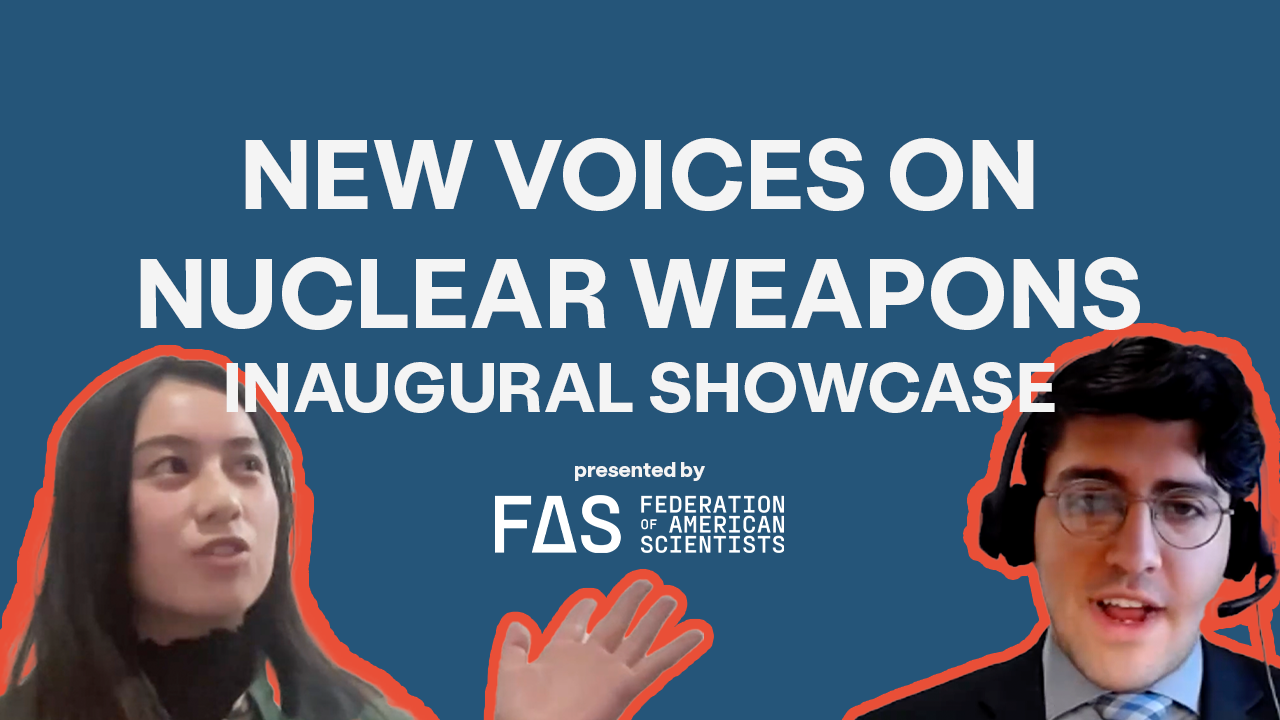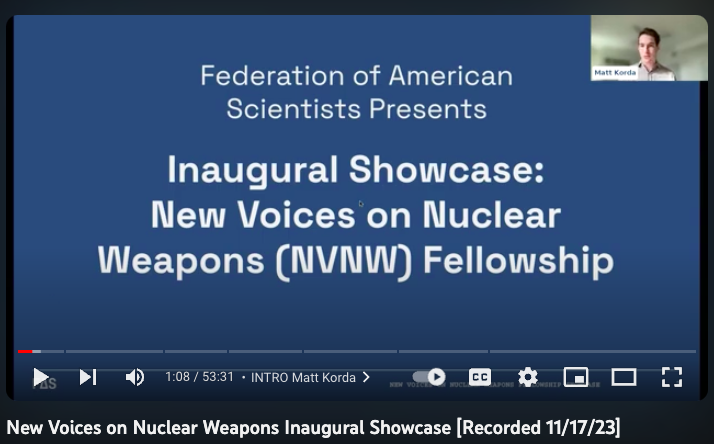
New Voices on Nuclear Weapons Fellowship: Creative Perspectives on Rethinking Nuclear Deterrence
After decades of reductions in the number and salience of nuclear weapons, they are once again at the center of international security. All nine nuclear-armed states are updating their arsenals, and several are expanding them. But despite new military technology and new risks, the concepts underpinning nuclear deterrence have changed little since the height of the Cold War. It is more important than ever that the nuclear policy community recruit new voices from diverse demographic and socioeconomic backgrounds to bring new perspectives, skills, and ideas into the field.
To empower new voices to start their career in nuclear weapons studies, the Federation of American Scientists launched the New Voices on Nuclear Weapons Fellowship. Between May and August 2023, each of our inaugural fellows–Anna Pluff, Clara Sherwood, Cameron Vega, and Charlotte Yeung–was paired with a senior academic or policy expert (John Emery, Jamie Withorne, Alan Robock, and Lovely Umayam) to co-author a research project that provides a creative perspective on nuclear deterrence policy.
As a culmination of this year’s fellowship, FAS hosted a showcase featuring presentations by fellows on their research following a Q&A session, as well as remarks by FAS staff on the fellowship’s structure, goals, and role in empowering the next generation of nuclear policy experts. A recording of the showcase is available for viewing below.
Fellowship Showcase
Fellowship Projects and Publications
New Voices on Nuclear Weapons fellows have had their research projects published across a variety of mediums. Please see below the fellows’ project summaries and publications related to this fellowship to date; this list will be updated as their research continues to be finalized.
Anna Pluff
In the early years of the Cold War, many scientists from the Manhattan Project fervently believed in the idea of “One World or None” and promoted nuclear one worldism. Though the scientific profession had relatively little experience with public engagement before the 1940s, scientists banded together to stretch the political possibilities of professional modes of association to foster support for world government. Anna’s case study looks at the historic role that scientific activism played in nuclear policy through one-worldism and how scientific activism can become a viable force in rethinking deterrence today.
Publications
- “Failed visionaries: Scientific activism and the Cold War” The Bulletin of the Atomic Scientists.
- “What “Oppenheimer” Misses About The Decision to Drop the Bomb” Inkstick Media.
- “Manhattan Project Scientists Believed the Way We Get Out Alive is World Government” Inkstick Media.
Clara Sherwood
Targeted disinformation and rapid digital communication are complicating nuclear deterrence and crisis management in an unprecedented manner. While nuclear discussions have traditionally occurred privately between governments, in the 21st century, there are a myriad of different actors participating in global nuclear conversations. Clara’s research aims to describe how digital narratives from non-governmental actors are contributing to escalation management, nuclear discourse, and nuclear rhetoric in the context of the Russian-Ukrainian War.
Publications
- “Exiting Musk’s Twitter Has Compromised Nuclear Communication Channels” Inkstick Media.
- “How nongovernmental entities are tailoring their outreach to address nuclear escalation” The Bulletin of the Atomic Scientists.
Cameron Vega
American nuclear deterrence inherently relies on ethical principles dictating the appropriate use of nuclear weapons; however, these ethical principles insufficiently consider modern scientific modeling demonstrating the devastating climatic impacts of nuclear use. Cameron’s research aims to update the ethical principles underpinning American nuclear deterrence to account for the realities of how nuclear strikes would affect the local environment and global climate change.
Publications
- “The climate blind spot in nuclear weapons policy” The Bulletin of the Atomic Scientists.
Charlotte Yeung
The nuclear narratives told and believed today are rooted in how nuclear weapons are discussed in schools, culture, and locality. The branching narratives in America and Japan are particularly distinct and told through different forms of official narratives taught in textbooks, visual aesthetics, preservation of nuclear-related sites, movements, and the military-industrial complex. Charlotte’s exhibit and poetry ask how education and culture are the roots through which come the multidimensional nature of how Americans and Japanese learn about nuclear weapons and how those define the systems that shape public opinion about nuclear weapons today in those two countries.
Publications
- Culture Blast: Tracing Nuclear Narratives (Online Research Project Website)
- “Culture Blast At The Kurt Vonnegut Museum” Federation of American Scientists
The Federation of American Scientists applauds the United States for declassifying the number of nuclear warheads in its military stockpile and the number of retired and dismantled warheads.
North Korea may have produced enough fissile material to build up to 90 nuclear warheads.
Secretary Austin’s likely certification of the Sentinel program should be open to public interrogation, and Congress must thoroughly examine whether every requirement is met before allowing the program to continue.
Researchers have many questions about the modernization of Pakistan’s nuclear-capable aircraft and associated air-launched cruise missiles.
